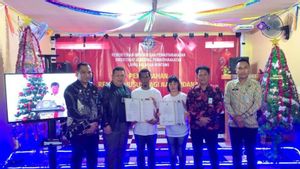JAKARTA - Indonesia's struggle for independence brought about a rupture of resistance in various regions. Many lives died fragrantly, as well as many heroes that we must remember.
We have known many heroes in the country, such as Imam Bonjol, Diponegoro, Pattimura, Cut Nyak Dien, Sisimangaraja, I Gusti Ngurah Rai, and many more. Their faces can be seen on the money sheet and in the school classroom.
But you know, we also have a national hero from Bangka Belitung. His figure is not widely recognized by people. But the service in repelling the invaders in bangka belitung land is very large.
National Hero of Bangka Belitung Depati AmirIn 2018, Indonesian President Joko Widodo gave the title of national hero of six figures. Of the six figures who are considered meritorious for the country there is the name Depati Amir from Bangka Belitung.
Depati Amir's heroism has been crowned by Jokowi through Presidential Decree No. 123/TK/year 2018. Depati Amir also became the first national figure from Bangka Belitung.
Amir was born in 1805 in Mendara, Bangka. He was the son of Depati Bahrin who was a Bangka nobleman. Amir then received a depati degree from the Dutch East Indies government. Depati is the name of the title that was crowned by the Sultanate of Palembang to the elites in Bangka.
But long before holding the title, Depati Amir had been instrumental in leading the local community to fight pirates who crossed bangka waters. When given the title, Amir refused. He prefers to live as a commoner.
But depati's title was still carried. The people of Bangka called him depati because it contributed greatly to Bangka. Despite declaring to be an ordinary people, Depati Amir was still supervised by the Dutch because of his great influence.
Depati Amir's resistance to the NetherlandsDepati Amir led the community against the Dutch. The sharing of tin mine trenches became the trigger for the resistance. Initially the cooperation went well. But then the Dutch company did not carry out its obligations. The Netherlands does not deposit the payment of mining proceeds.
Depati Amir then rebelled. He used Dutch companies to meet his demands. Bangka people clenched their fists and advanced in support of Depati Amir's struggle. They come from various community groups. Natives and ethnic Chinese who had long settled in Bangka came down to the battlefield.
The Suffering of the People of BangkaThe fight has actually been anticipated by bangka people for a long time. Both ethnicities have long suffered from forced labor for Dutch gain. They are employed every day in tin mines.
The two different ethnicities felt the same pain. They then devised a plan to rebel from Dutch rule. So not only the local people, the Chinese also played a role in the struggle against colonialism.
Indigenous and Ethnic Chinese Union Against the DutchPeople, ethnic Chinese, and local leaders move with Depati Amir. The inter-ethnic unity was documented in Dien Madjid's journal "Depati Amir and Chinese People's Resistance against Dutch Colonialism in Bangka, 1848-1851: An Archival Study".
In addition to the journal, the history of Depati Amir moving all ethnicities in Bangka to fight the Dutch is also contained in the documents of the National Archives of Indonesia.
The struggle of Bangka people under the direction of Depati Amir symbolizes the principle of diversity that has long been embraced by the ancestors. Depati Amir has long been a testament to the unity of ethnic diversity can generate a huge wave against the Dutch colonial.
Stay up to date with the latest domestic and overseas VOI news.
The English, Chinese, Japanese, Arabic, and French versions are automatically generated by the AI. So there may still be inaccuracies in translating, please always see Indonesian as our main language. (system supported by DigitalSiber.id)








